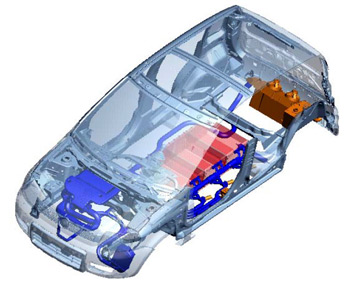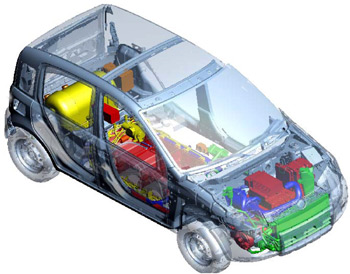|
Fiat is working full steam ahead on alternative fuel powered vehicles, with a fleet of fuel cell buses and Pandas taking part in tests across Italy. In Turin, Milano, Mantova, Arese, Genova, Firenze/Siena, and Napoli, hydrogen fuel stations have been constructed, and are supplying clean energy to a fleet of vehicles.
Five Fiat Pandas fitted with third-generation Fuel Cell technology are on the streets of Turin, along with Iveco Fuel Cell buses. In Milan, Mantova,
and Arese, no less than ten Fiat Panda Hydrogen cars are in circulation, along with
two hybrid fuel cell buses. Genova, Firenze/Siena, and Napoli similarly also have a fleet of prototype Pandas and buses.
The fleet tests will provide valuable information on how durability and overall performance of hydrogen fuel cell systems can be improved. Engineers also intend to extend the operating temperature of fuel cell systems (cold start-up and extreme temperatures). On board hydrogen handling and storage are also areas where improvements will be made, including important safety aspects.
Titled the EU-Zero Regio Program, the
five year duration project, which commenced on November 15th 2004, entails three main goals:
• Set up and test the Hydrogen chain for Transportation, from production to distribution.
• Verify User Acceptance of Fuel Cell Vehicles, and functionality of related infrastructure and services.
• Assess safety, cost issues, socio-economic and environmental impact.
Supported by the Ministry of Environment, Fiat are one of the
16 members taking part in the EU-Zero Regio Program
consortium, which also includes DaimlerChrysler as a key
player. Fiat are particularly focusing on the development of
fuel cell vehicles for urban applications. Motivations for
urban application include the high perceived benefit from
zero emissions in city centres, the limited H2
infrastructure, the limited range requirements and
consequent easier on board H2 storage. The urban setting also provides for a controlled environment for fleet tests.
|


 |
|
The
technology first used by Fiat on the year 2000 Fiat
Seicento FC APU prototype (above) is undergoing
continuous evolution; detailed cutaway view
of the 3rd generation fuel cell system (middle) as used on
the latest Fiat Panda prototypes (top). |
|

|
|
|

 |
|
The
latest third generation Fiat Panda fuel cell
vehicle is capable of reaching 50 km/h in under
5 seconds, and has a urban driving cycle
range of over 200 km. Prototypes have been
dispatched across Italy. |
|

|
|
|
Fiat’s first fuel cell rolling prototype dates back to 2000, with the Seicento FC
APU. In 2002, Centro Ricerche Fiat had a second generation fuel cell system in place, with a load follower
powertrain, and built yet another Seicento prototype, simply called the “Hydrogen”. 2004 saw a Fiat Panda prototype with a “Full Power” fuel cell system, the system being far more adapted to every day driving conditions. Now, in 2006, the project is stronger than ever before, with the third generation fuel cell system applied to a complete fleet of vehicles. The near future will also see a Fiat Doblò fuel cell car.
Fiat predict that fuel cell vehicle development will be supported by demonstration programs until 2010-2015, until a durability figure of 5000 hours is guaranteed, and power train costs lower than $100 per kW are achieved.
“The long-term strategic approach for the development of Hydrogen and Fuel Cell technologies calls for sharing of high level costs and risks. The automotive industry is willing to support this integrated process when based on clear agreements and commitments among all interested partners and stakeholders. A long lasting public-private partnership is a priority both at national/regional and European level for this coordinated and efficient system approach, which includes large and small Industries, public
administrations, research centres, academia, and users. Niche markets are also required to accelerate and sustain this effort. These markets can provide additional financial resources to R&D, with the involvement of additional stakeholders and users and the activation of specific incentives,”
concludes Giuseppe Rovera on behalf of Centro Ricerche Fiat.
3rd generation fuel cell vehicle: Panda Hydrogen
Payload: 4 seats;
Curb weight: 1150 kg;
Max speed: 130 km/h;
Acceleration time (0-50 km/h): 5 seconds;
Range (Urban Driving Cycle) > 200 km;
Gradeability @ full load: 23%;
Refuelling time: < 5 minutes
By
Paddy Granger
|
|
|
|
![]()
![]()